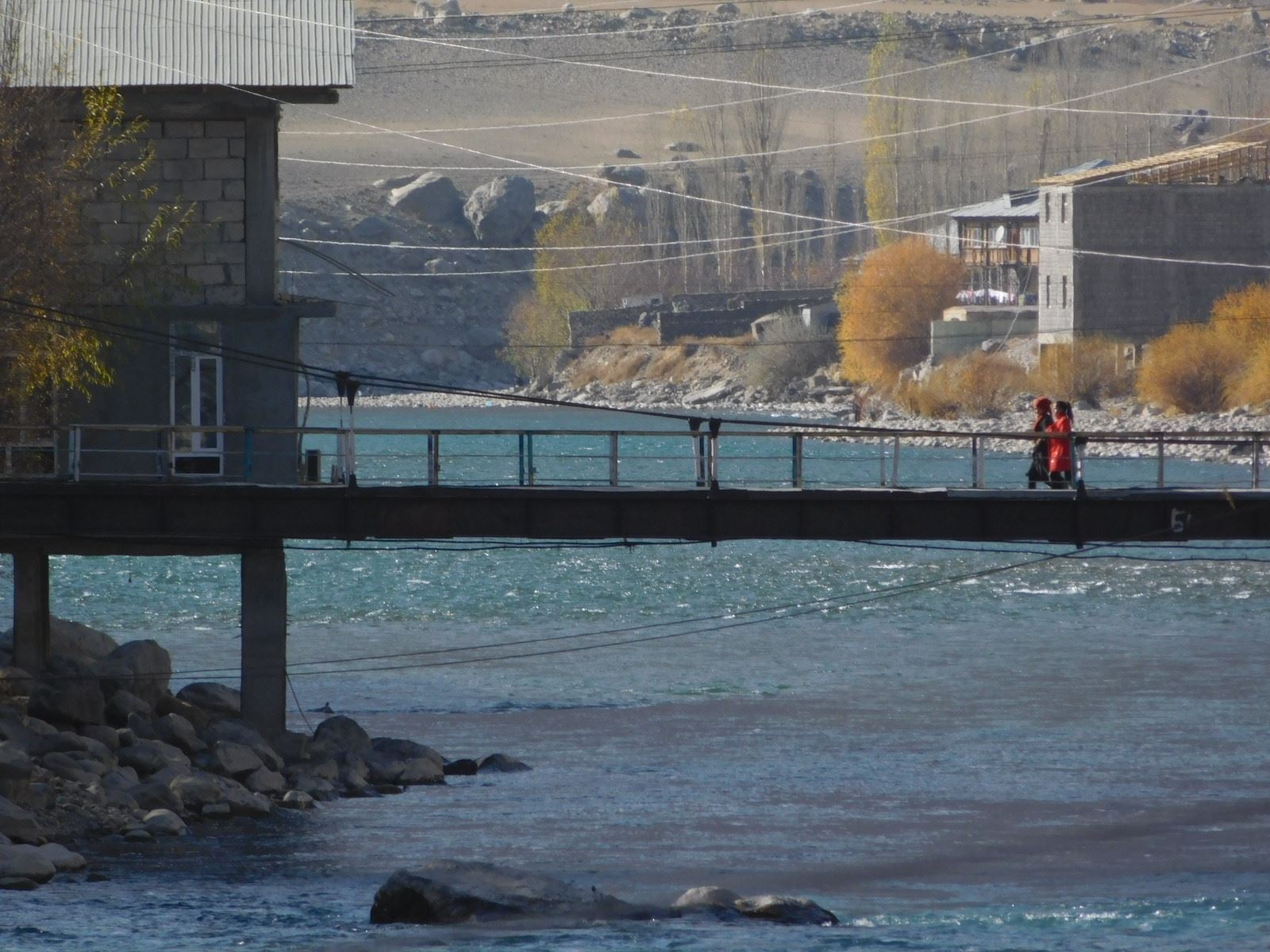Rows of sturdy, almost unnervingly elegant poplars line the river Gunt, which divides the town of Khorog, Tajikistan in half until it flows into the neighbouring Panj. The Panj eventually becomes the Amu Darya (the Oxus, for those up on their Latin), which in turn filled the Aral Sea, once upon a time. Stand on the east bank of the river and throw a stone: you will hit neighboring Afghanistan.
Khorog may be perched at the edge of Tajikistan, but it forms the administrative capital of the Gorno-Badakhshan Autonomous Region (GBAO), also called Badakhshan or simply ‘the Pamir.’ The residents will not let you forget they are Pamiri. Ask them about it and they will tell you about their traditional homes, their contribution to Tajik and Soviet Rock. Stick around long enough and they will get around to the biggest piece of news in years: the opening of their new Jamatkhana.

The word Jamatkhana (also spelt Jamaatkhana or Jam’at Khana) was minted from Arabic and Persian loanwords, roughly translating to ‘house of the congregation.’ It has traditionally been a central part of the life of Islamic communities known as the Ismaili, a group nestled firmly in the Shi’a branch of Islam under the guidance of their spiritual leader, the fourth Aga Khan. He is the formal head of the Nizari branch of Ismaili Islam, itself the second largest denomination in the Shi’a tradition.
There are Jamatkhanas in all parts of the world where Ismailis gather to worship: London, Dubai, Lisbon, Dhaka, Kinshasa, Toronto. They’re built as large centres, equipped with prayer spaces, libraries, educational centres and offices for secular and developmental support. They serve purposes similar to those of mosques, but they are never described as such in official practice. What makes the new Jamatkhana in Khorog so special, though, is that it is the first such officially-recognized house of prayer in a historically Ismaili-majority region.

The word ‘pamir’ is of uncertain etymology. Scholars have speculated that it could simply be a geographical term referring to a valley or plateau surrounded by mountains. It could also have derived from “the foot of Mithra” or “the roof of the world” in older Iranian languages. The Pamir is not a set of mountains so much as a busy intersection of valleys defined by some of the world’s most imposing ranges. From there, the Tian Shan veer into Kyrgyzstan, the Hindu Kush descend into Afghanistan, and the trident making up the Kunlun, Karakoram, and the Himalaya ranges go on to prop up the rim of the Tibetan Plateau.
Their relative impenetrability in the ancient world defined the region as a permanent frontier zone close to major trade routes. Waves of rulers and their armies came and went, including the Persians, the Mongols, the Turkic Khans, the Qing and even Alexander the Great. Through it all the Pamir remained a wall that frustrated attempts at invasion and effectively marked the boundaries of some of the world’s largest empires.

Wikimedia)
By the end of the nineteenth century this was still the case: they were surrounded by the Qing Chinese to the east, the British to the south and the Uzbek Khanates to the northwest, which were vassal-states of Tsarist Russia. Unable to resist these tensions, the greater Badakhshan region was split in two: the majority of the Pamirs were incorporated into the Russian Empire (along with most of Central Asia). The rest formed a panhandle-shaped buffer zone in Afghanistan known today as the Wakhan Corridor. Khorog, geographically, is nestled in the river valley serving as that border’s very spine.
The isolation of each of the Pamir’s river valleys provides a remarkable amount of geopolitical autonomy. Each valley houses groups with distinct dialects, customs and clothing – there is a regional joke with a punchline involving how you can identify a Pamiri’s birthplace by their choice of hat. Trade and communication between the groups themselves was difficult enough, to say nothing of stable contact with imperial centres.
In those very imperial centres, the history of Ismaili Islam was undergoing major changes in the 19th century. The first Aga Khan, Hassan Ali Shah, was bestowed his title in 1817 by Qajar Fath Ali Shah and married into the Qajar royal family. But following a dispute with Iranian authorities in the 1840s, the Agha Khan fled to British India where he began to consolidate control over local Ismaili communities through the the aid of colonial courts.

His grandson, the third Aga Khan, used his new position in the British empire to create the foundations for a transnational global Ismaili community and what would eventually become the Aga Khan Development Network (AKDN) under his successor, the current Imam, the fourth Aga Khan. The AKDN has taken an active role in regions across the developing world where Ismaili communities have been historically present, leading to infrastructural expansion and a greater degree of standardization in Nizari Ismaili practice.
While the global Ismaili community found increased unity in the 20th century, Soviet control over the Pamir prevented local Ismailis from being incorporated into this growing network. The collapse of the Soviet Union and the ensuing political crises ended the community’s isolation, and, in fact, many residents consider the end of the USSR to coincide with the present Aga Khan’s arrival.
What he found in Badakhshan (as Soviet ethnographers had noted) was not uncommon: local expressions of faith that did not always align with the textual sources of Islam or Ismaili practice elsewhere. Thus, despite its long history of Ismaili presence, the region never had an official Aga Khan-designated Jamatkhana such as those found in other parts of the world.
The construction of the new centre can be said to be a kind of translation of global Ismaili Islam into the Pamiri vernacular. To assist in its legibility, the project consciously aimed to be integrated into the environment and its norms. This not only meant using local materials, but also in incorporating Pamiri architectural forms.

Tsarist ethnography, aiming to depict its conquest of the Pamirs as a homecoming, connected all the archaeological remains that dot the Panj river, particularly south along the Afghan border, to an ancient Zoroastrian/Aryan past, of which the Pamiris were positioned as direct inheritors. While the connection between these ruins and an Aryan/Zoroastrian past is contentious, it does inform local explanations that dominate regional guidebooks and tours.

These books connect the roofless temples to contemporary Pamiri culture through the structure of the traditional Pamiri houses that still dot the landscape. The Pamir house is normally built of at least two large rooms – if you enter the smaller one through the main door, you will find its inhabitants eating dinner during the warmer seasons. The second room, however, is the real heart of the home. There are typically three horizontal zones, rising from an earth floor up to two raised platforms, representing the mineral, vegetable and animal realms.
The sun beams in through a skylight built in four concentric squares embodying the classical elements. Five pillars hold up the room, and Soviet ethnographers, who might have in turn inspired certain locals (and the resulting literature for tourists), identified them with five spirits associated with ancient Iranian traditions: Surush, Mehr, Anahita, Zamyod and Ozar.
Locals give an alternate explanation steeped in Islamic and Ismaili cosmology. The five pillars are associated with the ahl al-bayt, the family of the the prophet Mohammed, including his cousin and successor Ali, the prophet’s daughter and Ali’s wife, Fatima, as well as their children Hassan and Hussein. The number of beams in the ceiling are made to correspond to either the Army of Hussein (72), the prophets and caliphs (13) or the Ismaili Imams (49). At the top of the pillar representing Mohammed hangs a picture of the Aga Khan, itself a representation of a globalized community held together by a modern infrastructure. It is this synthesis of local Ismailism with the larger community that is now expressed in the Jamatkhana’s very building.

Khorog’s Ismaili Jamatkana and Centre (as it is officially known) opened in December 2018. Located on the banks of the Gunt River and covering over 4,700 square meters, the building has been billed as both a secular and religious congregational space as well as a boost to the economic development of the city. Built by architect Farouk Noormohamad, who is also responsible for designing multiple Ismaili centres including the one in Tajikistan’s Capital of Dushanbe, Khorog’s Jamatkhana incorporates many architectural elements from the Pamiri House and Badakhshan’s landscape at large, such as the open skylights, wooden pillars resembling local Arar trees, and stained glass windows inspired by Central Asian embroidery. Its opening was celebrated with much fanfare, and even included a visit and speech by the Aga Khan, who reiterated his commitment to transforming Khorog into the “Jewel of the Pamirs.”
Clearly, devotion to the Aga Khan is not solely due to his religious position, but also to his economic and political role in rebuilding Badakhshan following Tajikistan’s devastating civil war in the wake of the USSR’s collapse. The conflict prompted more involvement from the Aga Khan in the region, and many local Ismailis were more than happy to receive this support. His efforts are said to have prevented a humanitarian crisis – the AKDN provided food and relief at a time when getting any vehicle from Dushanbe to Khorog was (and still is) a quest. With Badakhshan’s relative isolation and the widespread damage from the civil war, the government allowed the Aga Khan a relatively free hand in rebuilding the region.

In the decades since, the Aga Khan Foundation has altered the face of Khorog. A fashionable tourist centre, echoing the architecture of the town’s one boutique hotel, overlooks a city park checkered with the poplars for which the town is famed. This new, Imam-driven prosperity in the region has not gone unnoticed: there are governmental concerns over the amount of power the Aga Khan possesses. Additional concerns concerns have been raised about how the Aga Khan’s “successes” may have taken advantage of opportunities provided by weak state infrastructure. That said, more often than not there has been an uneasy truce between him and Tajik president Emomali Rahmon.
But many Pamiris have expressed nothing but public devotion to their Imam. Even after suffering a government-led assault on Khorog as recently as 2013, many locals (who took up arms against the attack) claim the Aga Khan played a major role in mediating a resolution to the conflict. The Jamatkhana’s grand opening, with all the foreign capital behind it, does not merely reflect the region’s unique cultural and religious diversity: it is another move in the Aga Khan’s constant dance with Dushanbe over control over Pamiri minds, patronage politics, and economic development.

